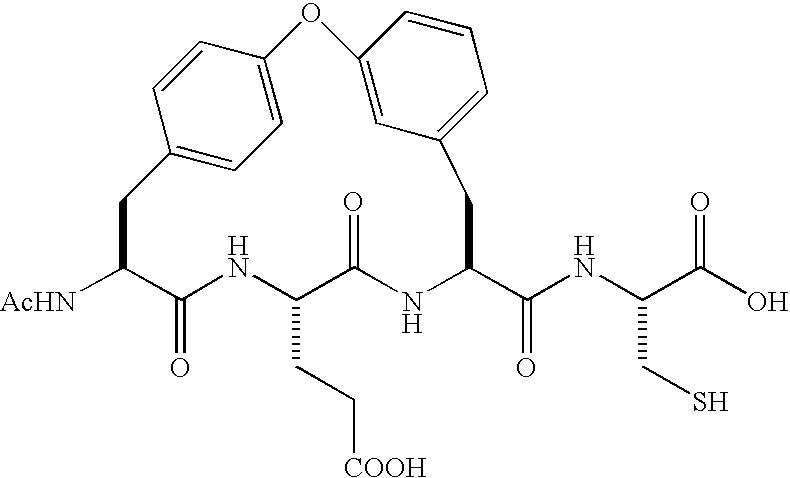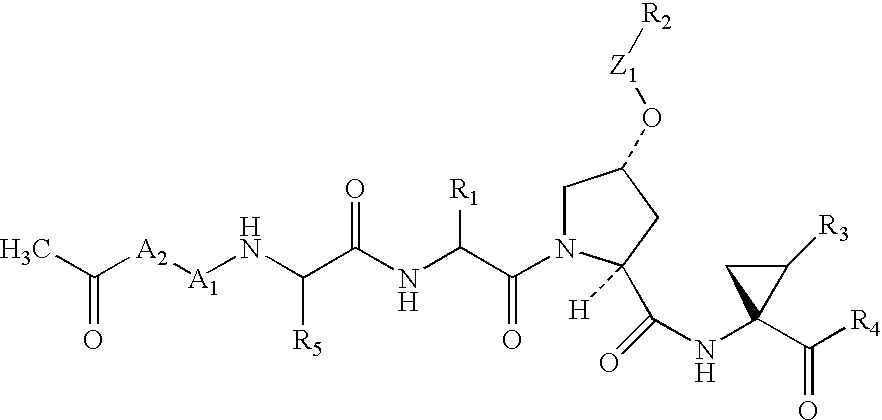Acylsulfonamide compounds as inhibitors of hepatitis C virus NS3 serine protease
a technology of acylsulfonamide and serine protease, which is applied in the direction of drug compositions, peptide sources, peptide/protein ingredients, etc., can solve the problems of low sustained response rate of therapies, frequent side effects, and poor treatment effect of patients with hcv infection
- Summary
- Abstract
- Description
- Claims
- Application Information
AI Technical Summary
Benefits of technology
Problems solved by technology
Method used
Image
Examples
examples
[0226] Preparation of Intermediate 1.01
[0227] The amino ester 1.01 was prepared following the method of R. Zhang and J. S. Madalengoitia (J. Org. Chem. 1999, 64, 330), with the exception that the Boc group was cleaved by the reaction of the Boc-protected amino acid with methanolic HCl (4M HCl in dioxane was also employed for the deprotection).
(Note: In a variation of the reported synthesis, the sulfonium ylide was replaced with the corresponding phosphonium ylide).
[0228] Preparation of Intermediate 1.04
[0229] A solution of Boc-tert-Leu 1.02 (Fluka, 5.0 g 21.6 mmol) in dry CH2Cl2 / DMF (50 mL, 1:1) was cooled to 0° C. and treated with the amine salt 1.02 (5.3 g, 25.7 mmol), NMM (6.5 g, 64.8 mmol) and BOP reagent (11.6 g, 25.7 mmol). The reaction was stirred at rt for 24 h, diluted with aq. HCl (1 M) and extracted with CH2Cl2. The combined organic layers were washed with HCl (aq, 1 M), sat'd. NaHCO3, brine, dried (MgSO4), filtered and concentrated in vacuo and purified by chromatog...
example 2
Preparation of Compound of Formula 2
[0237]
[0238] To a cooled solution (0° C.) of the intermediate 1.04 (75.0 mg, 0.20 mmol) and 1.09 (100.0 mg, 0.36 mmol) in DMF (5.0 mL) was added HATU (Aldrich, 76.05 mg, 0.20 mmol), followed by DIPEA (0.102 mL, 6 mmol). The reaction mixture was stirred for two days then warmed up to room temperature, diluted with ethyl acetate (40.0 mL), washed with 5% KH2PO4 containing 0.05 vol. of 1M H3PO4 and brine. The organic layer was dried over MgSO4, filtered and concentrated to dryness. Residue was purified over silica gel using acetone-CH2Cl2 (1:9 to 1:1) to get 34.0 mg of product of formula 2 (28% yield); LCMS: (591.1: M+1).
example 3
Preparation of Compound of Formula 3
[0239]
[0240] To a cooled solution (0° C.) of the intermediates 1.06 (75.0 mg, 0.2 mmol) and 1.09 (100.0 mg, 0.36 mmol) in DMF (5.0 mL) was added HATU (Aldrich, 76.05 mg, 0.20 mmol), followed by DIPEA (0.102 mL, 6 mmol). The reaction mixture was stirred for two days then warmed up to room temperature, diluted with ethyl acetate (40.0 mL), washed with 5% KH2PO4 containing 0.05 vol. of 1M H3PO4 and brine. Organic layer was dried over MgSO4, filtered and concentrated to dryness. Residue was purified over silica gel using acetone-CH2Cl2 (1:9 to 1:1) to get 8.0 mg of product of formula 3 (6.5% yield); LCMS: (590.1).
PUM
| Property | Measurement | Unit |
|---|---|---|
| pH | aaaaa | aaaaa |
| pH | aaaaa | aaaaa |
| volume | aaaaa | aaaaa |
Abstract
Description
Claims
Application Information
 Login to View More
Login to View More - R&D
- Intellectual Property
- Life Sciences
- Materials
- Tech Scout
- Unparalleled Data Quality
- Higher Quality Content
- 60% Fewer Hallucinations
Browse by: Latest US Patents, China's latest patents, Technical Efficacy Thesaurus, Application Domain, Technology Topic, Popular Technical Reports.
© 2025 PatSnap. All rights reserved.Legal|Privacy policy|Modern Slavery Act Transparency Statement|Sitemap|About US| Contact US: help@patsnap.com



